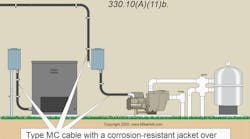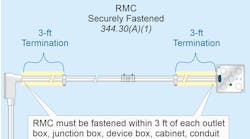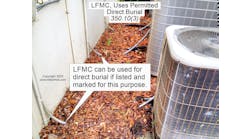Courtesy of www.MikeHolt.com
All questions and answers are based on the 2023 NEC.
(A) General Uses. Type MC cable can be used:
(1) For branch circuits, feeders, and services.
(2) For power, lighting, control, and signaling circuits.
(3) For indoor or outdoor locations.
(4) Exposed or concealed.
(5) To be directly buried (if identified for the purpose).
(6) In a cable tray.
(7) In a raceway.
(8) As aerial cable on a messenger.
(9) In hazardous (classified) locations as permitted in Sec. 501.10(B), Sec. 502.10(B), and Sec. 503.10.
(10) Embedded in plaster or brick in dry locations.
(11) In wet locations, where a corrosion-resistant jacket is provided over the metallic sheath and any of the following conditions are met:
a. The metallic covering is impervious to moisture.
b. A jacket is provided under the metal covering that is moisture resistant (see the Figure below).
(B) Specific Uses.
(1) Cable Tray. Type MC cable can be installed in a cable tray in accordance with Art. 392.
(2) Direct Buried. Direct-buried cables must be protected in accordance with Sec. 300.5.
(3) Installed as Service-Entrance Cable. Type MC cable is permitted to be used as service-entrance cable when installed in accordance with Sec. 230.43.
(4) Installed Outside Buildings. Type MC cable installed outside buildings must comply with Sec. 225.10, Sec. 396.10, and Sec. 396.12.
Note: The “Uses Permitted” is not an all-inclusive list, which indicates other suitable uses are permitted if approved by the authority having jurisdiction.
Type MC cable is not permitted to be used where:
(1) Subject to physical damage.
(2) Exposed to the destructive corrosive conditions in (a) or (b), unless the metallic sheath or armor is resistant to the conditions or protected by material resistant to the conditions:
a. Direct burial in the earth or embedded in concrete unless identified for the application.
b. Exposed to cinder fills, strong chlorides, caustic alkalis, or vapors of chlorine or hydrochloric acids.
Type MC cable installed through or parallel to framing members or furring strips must be protected against physical damage from the penetration of screws or nails by maintaining a 1¼-in. separation, or by installing a suitable metal plate in accordance with Sec. 300.4(A), (C), and (D).
These materials are provided by Mike Holt Enterprises in Leesburg, Fla. To view Code training materials offered by this company, visit www.mikeholt.com/code.






